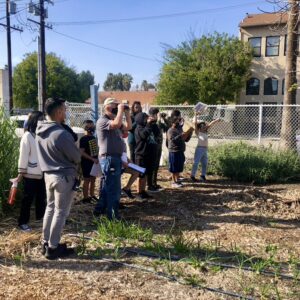
Some of my most cherished childhood memories are of following deer trails through the woods, becoming mystified by the transformation of a caterpillar into a butterfly, and studying algae at our school’s ecology site. Now I can see how these moments were deeply formative for how I relate to God’s world in all its whimsy, awe, and loveliness. At A Rocha, we understand that igniting a child’s joy and curiosity towards creation is an essential part of restoring peoples and places. All around the world, our programs equip children with the skills and knowledge to meet the environmental needs of their local communities, and we do this with a spirit of love for God’s creation.
In Southern California, where I live, A Rocha USA has spent the last year leading environmental education at a community-based local organization, Pomona Hope. At their after-school and summer enrichment programs, SoCal director Mark McReynolds has been in the community garden, teaching about birds, plants, weather, and camping to a group of children who are learning to see ordinary creatures in a new way.
Although Pomona is nestled right at the base of the San Bernardino mountains, many of the children have never spent significant time outside the city; the windy trails up to Mount Baldy and down along the San Antonio Creek are less than an hour away, but they can feel strange and inaccessible. As Mark explains, our goal is to “introduce kids to a form of recreation that gets them outside in God’s creation.” To this end, at the summer enrichment program, he simulated an entire camping experience with workshops on camping, cooking, and hiking complete with tents, sleeping bags, backpacking stoves, and freeze-dried food.
At the after school program, Mark set up a weather station where each week students learned to use a variety of instruments to analyze weather over time. We also had a “sit spot”, where students would pick their favorite part of the community garden to be still for a little while and observe their environment: mainly, they were excited by strange insects they hadn’t noticed while tromping around.
Staying true to A Rocha’s roots, we have also introduced the students to birdwatching. After a lesson on identification (and a humorous demonstration of a duck whistle), students took turns with binoculars and notebooks to identify, count, and record all of the birds on and around a feeder we set up. Among the many species identified, we saw an Anna’s Hummingbird with his distinguished pink throat, an adorably named Yellow Rump Warbler, and an exciting variety of finches. Children learn remarkably quickly: one student pointed out a large nest on the side of the church that I never would have noticed, and another patiently explained to me the difference between crows and ravens. But they also have a sense of humor about it all; at the end of our lesson, a crow flew into the garden and our young expert cried, “I love that bird! I named that bird Chris!”
Beyond education, we have young people actively participate in conservation work. We send the students’ birding data to Project FeederWatch where it is used by scientists to analyze changes in bird distribution and abundance throughout North America. This echoes A Rocha USA’s past project at Coastal Community School in Florida, where we conduct microplastics studies with students. These citizen science projects offer young people the opportunity to care for God’s creation where they live and contribute to long term solutions.
Through A Rocha International’s environmental education programs, children lead communities in imaginative solutions for the ecological problems they face: for instance, at our program in Kenya, children and parents preserve local forests by learning to grow and plant tree seedlings to use for firewood; in Peru, young people have run environmental activities and even redesigned a main street to provide green areas.
As I’ve grown into adulthood, I have a deepening grasp of the science behind certain phenomena; the interconnectedness of animals, people, plants, and fungi; and the theology around our relationship with God’s creation. Sometimes I have moments of awe or joy in nature, but I’ve largely lost the spontaneous delight in God’s indecipherable earth that I experienced as a child. In her exuberant collection of essays, The Everybody Ensemble, Amy Leach describes where the adult preoccupation with “categorization, interpretation, and taxonomy” leads us:
[I]f the whole confusing pantomime were finally decoded, there would be no birds, or herds, or nerds: just words. The world deciphered would be like the ceiling of the Sistine Chapel with the figures sponged off and, in their place, cards reading “Angel,” “Angel,” “God”’ “Zerubbabel.” (20-21)
For children, this is not so. When young ones move about the natural world, there is astonishment, joy, curiosity. We adults may learn from them the art of simply beholding the mysteries of God’s creation and feeling an uninhibited excitement by what we find.








The amazing blog is explained in great ways. I really appreciate the writer writing such fantastic stories and blogs. Thanks